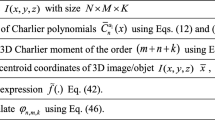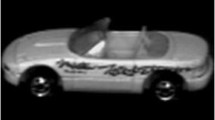Abstract
Objects classification or object detection is one of the most challenging tasks in computer vision. Digital images taken of real-life scenes capture objects at different positions, rotations and scales. Furthermore, variations in lighting, shape, color and texture within the same class make object classification a huge obstacle for computer vision algorithms. The most robust methodologies related to variations in lighting, rotation, color and scale, are based on “key points” localization, followed by applying a local descriptor to each surrounding region. Researchers have used various methods for detecting key points and have applied various local descriptors. Of these, the Scale-Invariant Feature Transform (SIFT), Speeded Up Robust Features (SURF) and Center-Symmetric Local Binary Pattern (CS-LBP) methods have obtained good performance and are associated with clustering algorithms or histogram representation based on independent features (Bag of Features (BoF)). In the BoF approach, the visual codebook extracted around the “key points” regions can effectively describe objects by their appearance based on local texture analysis. Recently, we proposed two new texture descriptors for object detection based on the Local Mapped Pattern (LMP) approach. The Mean-Local Mapped Pattern (M-LMP) and the Center Symmetric Local Mapped Pattern (CS-LMP) exhibit better performance than SIFT and CS-LBP, but prior results have shown that the size of descriptors could be reduced without loss of sensitivity. In this paper, we investigated reducing the size of the M-LMP descriptor and then evaluating its performance for object classification by a Support Vector Machine (SVM) classifier. In our experiments, we implemented an object recognition system based on the M-LMP reduced descriptor, and compared our results against the SIFT, Local Intensity Order Pattern (LIOP) and CS-LMP descriptors. The object classification results were analyzed using a BoF model and a SVM classifier, with the result that performance using the reduced descriptor is better than the other three well-known methods tested and also requires less processing time.



























Similar content being viewed by others
References
Abdel-Hakim A E, Farag A A (2006) Csift: a sift descriptor with color invariant characteristics. Proc 2006 IEEE Comput Soc Conf Comput Vis Pattern Recog (CVPR’06) 2:1978–1983
Bai G, Zhu Y, Ding Z (2008) A hierarchical face recognition method based on local binary pattern. CISP08 Proc 2008 Congress Image Signal Process 2:610–614
Bay H, Tuytelaars T, Gool L V (2006) Surf: speeded up robust features. Eur Conf Comput Vis 1:404–417
Cai H, Mikolajczyk K, Matas J (2011) Learning linear discriminant projections for dimensionality reduction of image descriptors. Pattern Anal Mach Intell 33(2):338–352
Elkan C (2003) Using the triangle inequality to accelerate k-means. In: Proceedings of the twentieth international conference on machine learning
Ferraz CT, Junior OP, Gonzaga A (2014) Feature description based on center-symmetric local mapped patterns. In: 29th Symposium on applied computing, pp 39–44
Ferraz C T, Junior O P, Rosa M V, Gonzaga A (2014) Object recognition based on bag of features and a new local pattern descriptor. Int J Pattern Recog Artif Intell 28(8):1455,010–1–1455,010–32. doi:10.1142/S0218001414550106
Heikkilä M, Pietikäinen M, Schmid C (2009) Description of interest regions with local binary patterns. Pattern Recog 42:425–436
Hoiem D, Chodpathumwan Y, Dai Q (2012) Diagnosing error in object detectors. Comput Vis (ECCV) 7574:340–353
Hou J, Kang J, Qi N (2010) On vocabulary size in bag-of-visual-words representation, vol 6297. Springer-Verlag Berlin Heidelberg, pp 414–424
Hua G, Brown M, Winder S (2007) Discriminant embedding for local image descriptors. In: Computer vision, ICCV, pp 1–8
Iscen A, Tolias G, Gosselin P H, Jegou H (2015) A comparison of dense region detectors for image search and fine-grained classification. IEEE Trans Image Process 24(8):2369–2381
Jgou H, Douze M, Schmid C (2011) Improving bag-of-features for large scale image search. Int J Comput Vis 87(3):316–336
Jin H, Liu Q, Lu H, Tong X (2004) Face detection using improved lbp under bayesian framework. In: Proceedings of the third international conference on image and graphics, pp 306–309
Jurie F, Triggs B (2005) Creating efficient codebooks for visual recognition. In: ICCV, vol 1, pp 604–610
Ke Y, Sukthankar R (2004) Pca-sift: a more distinctive representation for local image descriptors. Comput Vis Pattern Recog 2:506–513
KMikolajczyk, Schmid C (2005) A performance evaluation of local descriptors. IEEE Trans Pattern Anal Mach Intell 27(10):1615–1630
Lazebnik S, Schmid C, Ponce J (2006) Beyond bags of features: spatial pyramid matching for recognizing natural scene categories. IEEE Conf Comput Vis Pattern Recog 2:2169–2178
Leibe B, Leonardis A, Schiele B (2007) Robust object detection with interleaved categorization and segmentation. Int J Comput Vis 77(1):259–289
Lowe D G (1999) Object recognition from local scale-invariant features. In: International conference on computer vision, pp 1150–1157
Lowe D G (2004) Distinctive image features from scale-invariant keypoints. Int J Comput Vis 60:91–110
MacQueen J B (1967) Some methods for classification and analysis of multivariate observations. Proc 5th Berkeley Symp Math Stat Probab 1:281–297
Mikolajczyk K, Matas J (2007) Improving descriptors for fast tree matching by optimal linear projection. In: IEEE 11th international conference on computer vision, pp 1–8. doi:10.1109/ICCV.2007.4408871
Mikolajczyk K, Schmid C (2002) An affine invariant interest point detector. In: Proceedings of the 7th European conference on computer vision-part I, ECCV ’02. http://dl.acm.org/citation.cfm?id=645315.649184. Springer-Verlag, London, pp 128–142
Mikolajczyk K, Schmid C (2004) Scale & affine invariant interest point detectors. Int J Comput Vis Kluwer Acad Publ Hingham, MA USA 60(1):63–86
Nister D, Stewenius H (2006) Scalable recognition with a vocabulary tree. CVPR ’06 Proc 2006 IEEE Comput Soc Conf Comput Vis Pattern Recog 2:2161–2168. doi:10.1109/CVPR.2006.264
Nowak E, Jurie F, Triggs B (2006) Sampling strategies for bag-of-features image classification. In: Computer vision ECCV 2006, lecture notes in computer science. doi:10.1007/11744085_38, vol 3954. Springer, Berlin, pp 490–503
Ojala T, MPietikäinen DHarwood (1996) A comparative study of texture measures with classification based on feature distributions. Pattern Recog 29(1):51–59
Papageorgiou C, Poggio T (2000) A trainable system for object detection. Int J Comput Vis 38(1):15–33. doi:10.1023/A:1008162616689
Pelleg D, Moore A W (2000) X-means: extending k-means with efficient estimation of the number of clusters. In: Proceeding ICML ’00 proceedings of the seventeenth international conference on machine learning, pp 727–734
Perronnin F, Dance C, Csurka G, Bressan M (2006) Adapted vocabularies for generic visual categorization. Comput Vis ECCV 2006(3954):464–475
Schneiderman H, Kanade T (2000) A statistical method for 3d object detection applied to faces and cars. Comput Vis Pattern Recog 1:746–751
Sivic J, Zisserman A (2003) Video google: a text retrieval approach to object matching in videos. In: Proceedings of the ninth IEEE international conference on computer vision (ICCV’03)
Steinbach M, Karypis G, Kumar V (2000) A comparison of document clustering techniques. In: KDD workshop on text mining
Streicher A, Burkhardt H, Fehr J (2009) A bag of features approach for 3d shape retrieval. In: International symposium on visual computing
Vedaldi A, Fulkerson B (2010) Vlfeat: an open and portable library of computer vision algorithms. In: Proceedings of the international conference on multimedia, MM ’10. doi:10.1145/1873951.1874249. ACM, New York, pp 1469–1472
Vedaldi A, Zisserman A (2012) Efficient additive kernels via explicit feature maps. IEEE Trans Pattern Anal Mach Intell 34(3):480–492
Viola P, Jones M J (2004) Robust real-time face detection. Int J Comput Vis 57(2):137–154
Wan Z, Fan B, Wu F (2011) Local intensity order pattern for feature description. Comput Vis (ICCV):603–610
Yuan X, Yu J, Qin Z, Wan T (2011) A sift-lbp image retrieval model based on bag-of-features. In: 18th IEEE international conference on image processing, pp 1061–1064
Zhang S, Tian Q, Hua G, Huang Q, Li S (2009) Descriptive visual words and visual phrases for image applications. In: ACM multimedia, pp 19–24
Zhao G, Chen L, Chen G, Yuan J (2010) Kpb-sift: acompact local feature descriptor. In: MM ’10 Proceedings of the international conference on Multimedia, pp 1175–1178
Acknowledgments
The authors would like to thank the São Paulo Research Foundation (FAPESP), grant #2015/20812-5, and National Council for Scientific and Technological Development (CNPQ) for their financial support of this research.
Author information
Authors and Affiliations
Corresponding author
Rights and permissions
About this article
Cite this article
Ferraz, C.T., Gonzaga, A. Object classification using a local texture descriptor and a support vector machine. Multimed Tools Appl 76, 20609–20641 (2017). https://doi.org/10.1007/s11042-016-4003-0
Received:
Revised:
Accepted:
Published:
Issue Date:
DOI: https://doi.org/10.1007/s11042-016-4003-0




